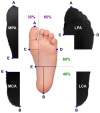Feature Ranking by Variational Dropout for Classification Using Thermograms from Diabetic Foot Ulcers
- PMID: 36679552
- PMCID: PMC9867159
- DOI: 10.3390/s23020757
Feature Ranking by Variational Dropout for Classification Using Thermograms from Diabetic Foot Ulcers
Abstract
Diabetes mellitus presents a high prevalence around the world. A common and long-term derived complication is diabetic foot ulcers (DFUs), which have a global prevalence of roughly 6.3%, and a lifetime incidence of up to 34%. Infrared thermograms, covering the entire plantar aspect of both feet, can be employed to monitor the risk of developing a foot ulcer, because diabetic patients exhibit an abnormal pattern that may indicate a foot disorder. In this study, the publicly available INAOE dataset composed of thermogram images of healthy and diabetic subjects was employed to extract relevant features aiming to establish a set of state-of-the-art features that efficiently classify DFU. This database was extended and balanced by fusing it with private local thermograms from healthy volunteers and generating synthetic data via synthetic minority oversampling technique (SMOTE). State-of-the-art features were extracted using two classical approaches, LASSO and random forest, as well as two variational deep learning (DL)-based ones: concrete and variational dropout. Then, the most relevant features were detected and ranked. Subsequently, the extracted features were employed to classify subjects at risk of developing an ulcer using as reference a support vector machine (SVM) classifier with a fixed hyperparameter configuration to evaluate the robustness of the selected features. The new set of features extracted considerably differed from those currently considered state-of-the-art but provided a fair performance. Among the implemented extraction approaches, the variational DL ones, particularly the concrete dropout, performed the best, reporting an F1 score of 90% using the aforementioned SVM classifier. In comparison with features previously considered as the state-of-the-art, approximately 15% better performance was achieved for classification.
Keywords: deep learning; diabetic foot; feature extraction; infrared; thermography.
Conflict of interest statement
The authors declare no conflict of interest. The funders had no role in the design of the study; in the collection, analyses, or interpretation of data; in the writing of the manuscript; or in the decision to publish the results.
Figures




Similar articles
-
State-of-the-Art Features for Early-Stage Detection of Diabetic Foot Ulcers Based on Thermograms.Biomedicines. 2023 Dec 2;11(12):3209. doi: 10.3390/biomedicines11123209. Biomedicines. 2023. PMID: 38137430 Free PMC article.
-
A Novel Machine Learning Approach for Severity Classification of Diabetic Foot Complications Using Thermogram Images.Sensors (Basel). 2022 Jun 2;22(11):4249. doi: 10.3390/s22114249. Sensors (Basel). 2022. PMID: 35684870 Free PMC article.
-
Thermal Change Index-Based Diabetic Foot Thermogram Image Classification Using Machine Learning Techniques.Sensors (Basel). 2022 Feb 24;22(5):1793. doi: 10.3390/s22051793. Sensors (Basel). 2022. PMID: 35270938 Free PMC article.
-
FusionSegNet: Fusing global foot features and local wound features to diagnose diabetic foot.Comput Biol Med. 2023 Jan;152:106456. doi: 10.1016/j.compbiomed.2022.106456. Epub 2022 Dec 21. Comput Biol Med. 2023. PMID: 36571939 Review.
-
A comprehensive review of methods based on deep learning for diabetes-related foot ulcers.Front Endocrinol (Lausanne). 2022 Aug 8;13:945020. doi: 10.3389/fendo.2022.945020. eCollection 2022. Front Endocrinol (Lausanne). 2022. PMID: 36004341 Free PMC article. Review.
Cited by
-
Advances in Machine Learning-Aided Thermal Imaging for Early Detection of Diabetic Foot Ulcers: A Review.Biosensors (Basel). 2024 Dec 13;14(12):614. doi: 10.3390/bios14120614. Biosensors (Basel). 2024. PMID: 39727879 Free PMC article. Review.
-
Prognostic value of the site, depth, and infection/ischemia classification system in diabetic foot ulcers: a retrospective cohort study.Sci Rep. 2025 Jul 24;15(1):27003. doi: 10.1038/s41598-025-06509-5. Sci Rep. 2025. PMID: 40707499 Free PMC article.
-
State-of-the-Art Features for Early-Stage Detection of Diabetic Foot Ulcers Based on Thermograms.Biomedicines. 2023 Dec 2;11(12):3209. doi: 10.3390/biomedicines11123209. Biomedicines. 2023. PMID: 38137430 Free PMC article.
-
Machine learning for diabetic foot care: accuracy trends and emerging directions in healthcare AI.Front Public Health. 2025 Jul 18;13:1613946. doi: 10.3389/fpubh.2025.1613946. eCollection 2025. Front Public Health. 2025. PMID: 40756392 Free PMC article.
-
N4-acetylcytidine modification of LncRNA GFOD1-AS1 promotes high glucose-induced dysfunction in human dermal microvascular endothelial cells through stabilization of DNMT1 protein.Funct Integr Genomics. 2025 May 24;25(1):107. doi: 10.1007/s10142-025-01617-x. Funct Integr Genomics. 2025. PMID: 40411601 Free PMC article.
References
-
- Sun H., Saeedi P., Karuranga S., Pinkepank M., Ogurtsova K., Duncan B.B., Stein C., Basit A., Chan J.C., Mbanya J.C., et al. IDF Diabetes Atlas: Global, regional and country-level diabetes prevalence estimates for 2021 and projections for 2045. Diabetes Res. Clin. Pract. 2022;183:109119. doi: 10.1016/j.diabres.2021.109119. - DOI - PMC - PubMed
MeSH terms
Grants and funding
LinkOut - more resources
Full Text Sources
Medical

